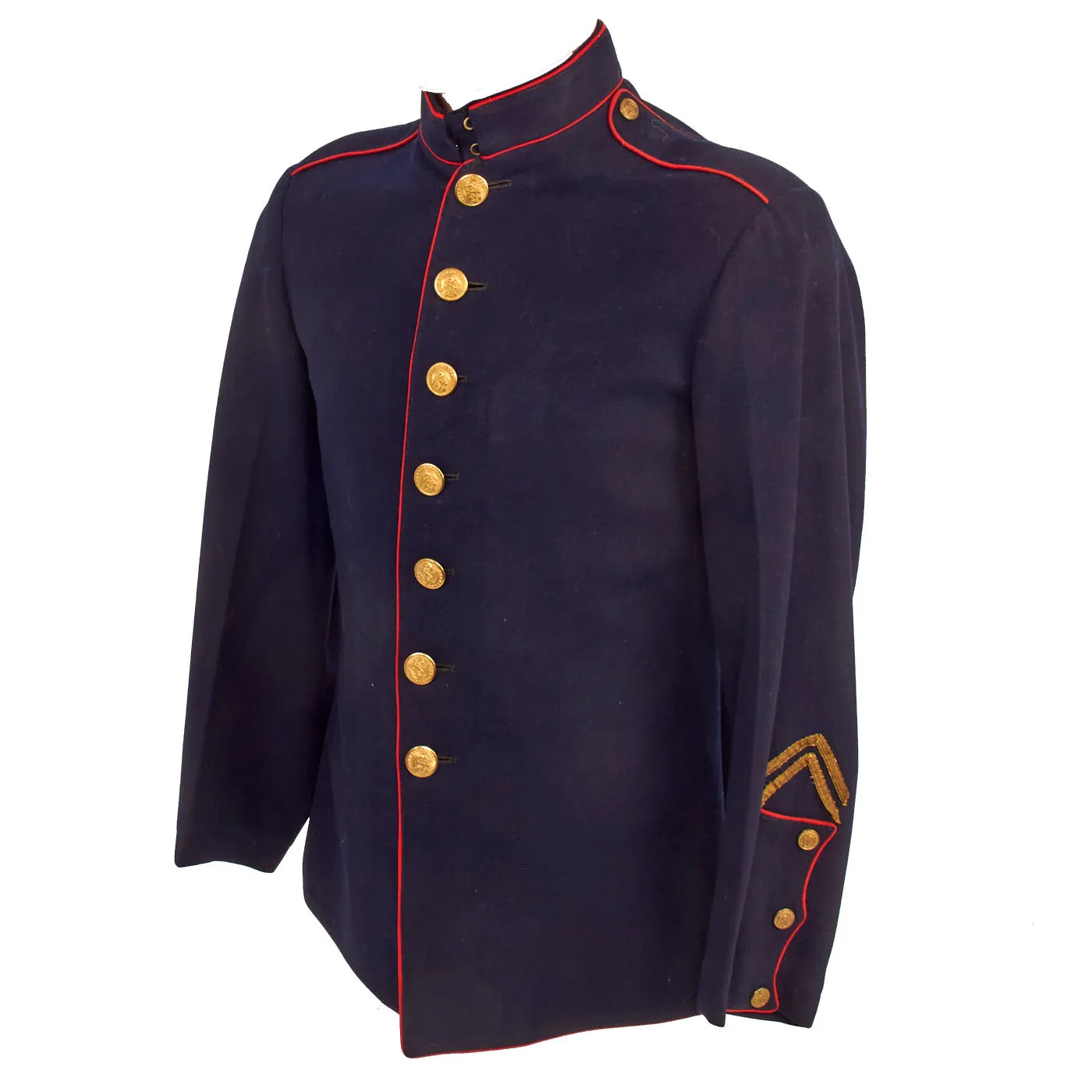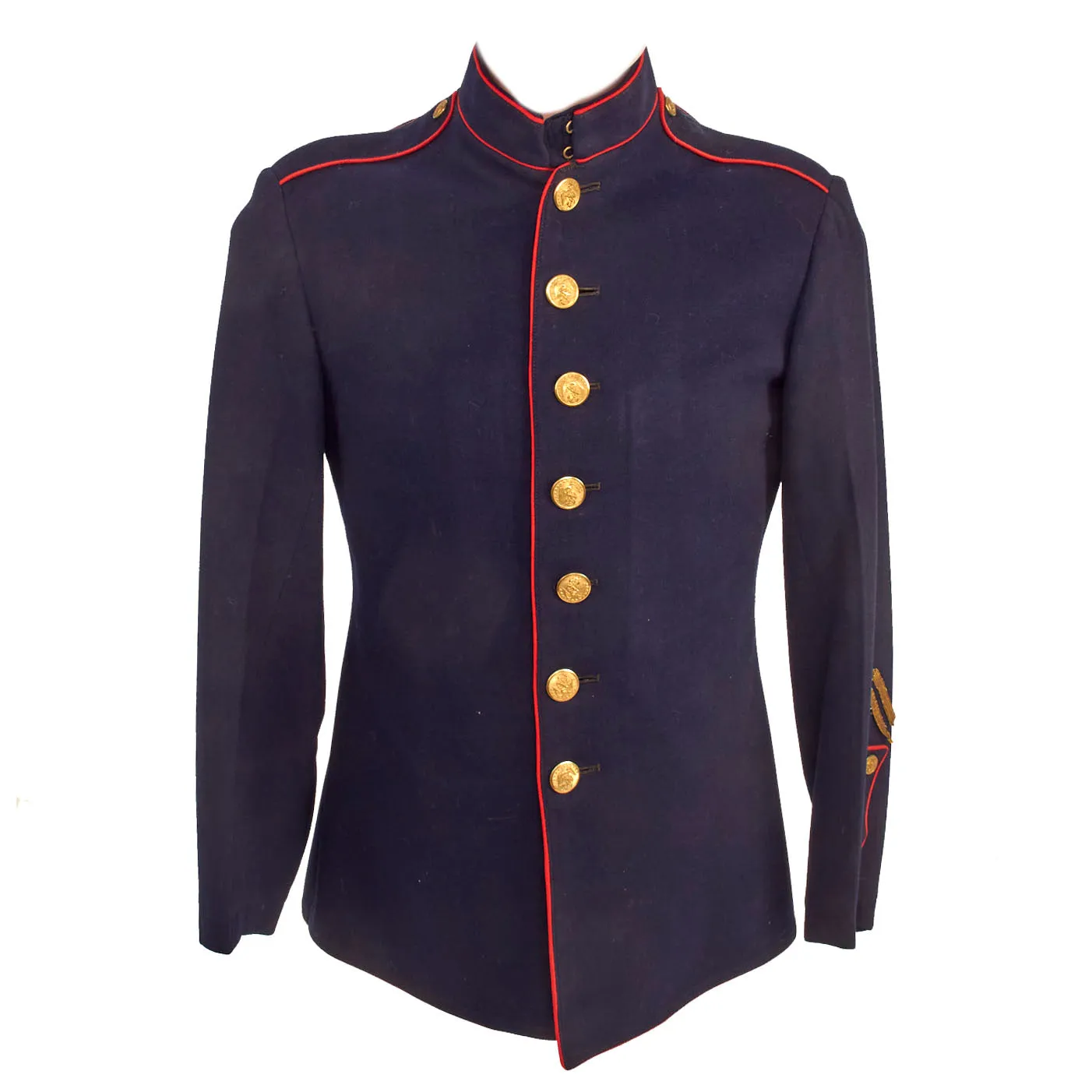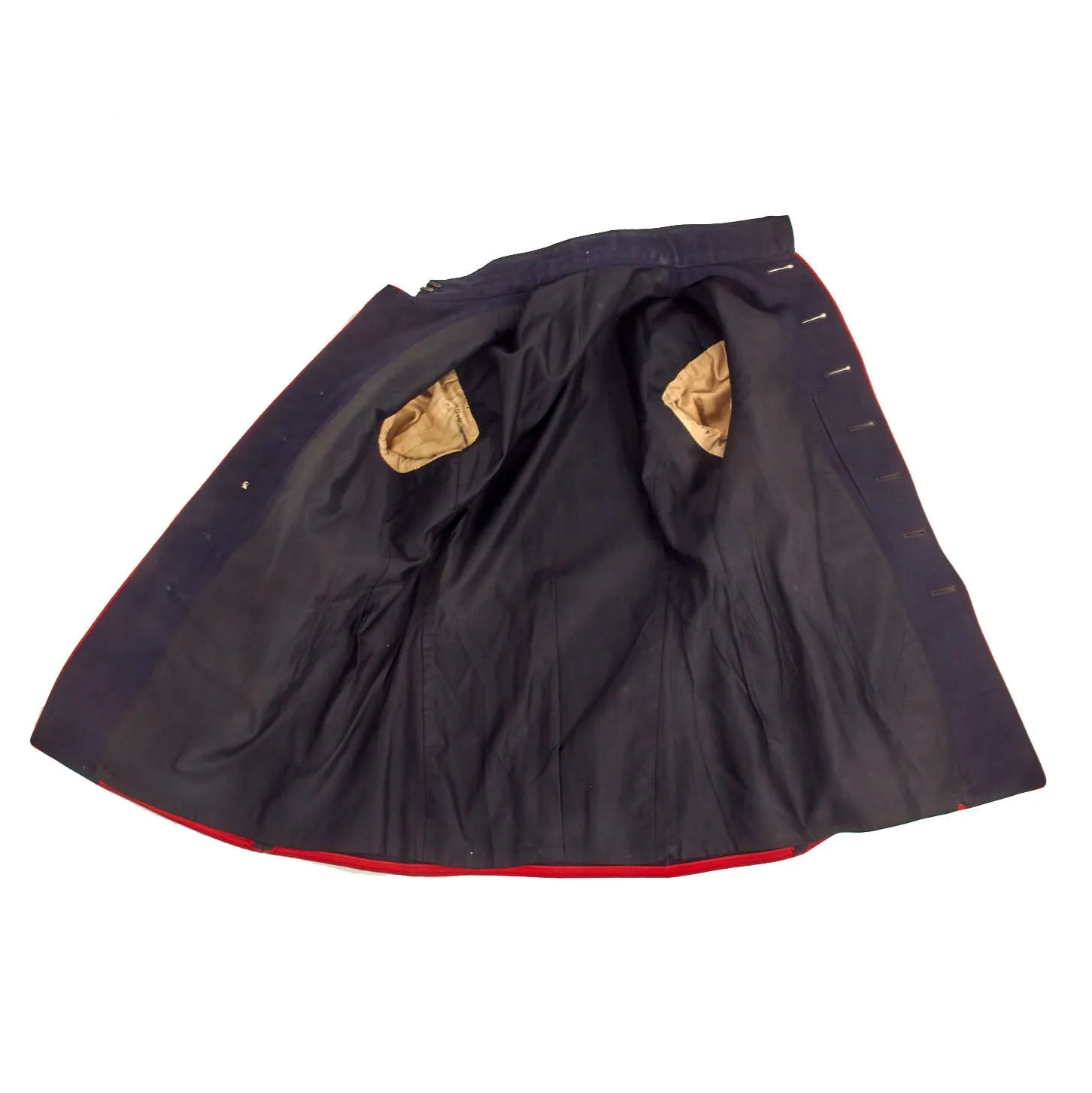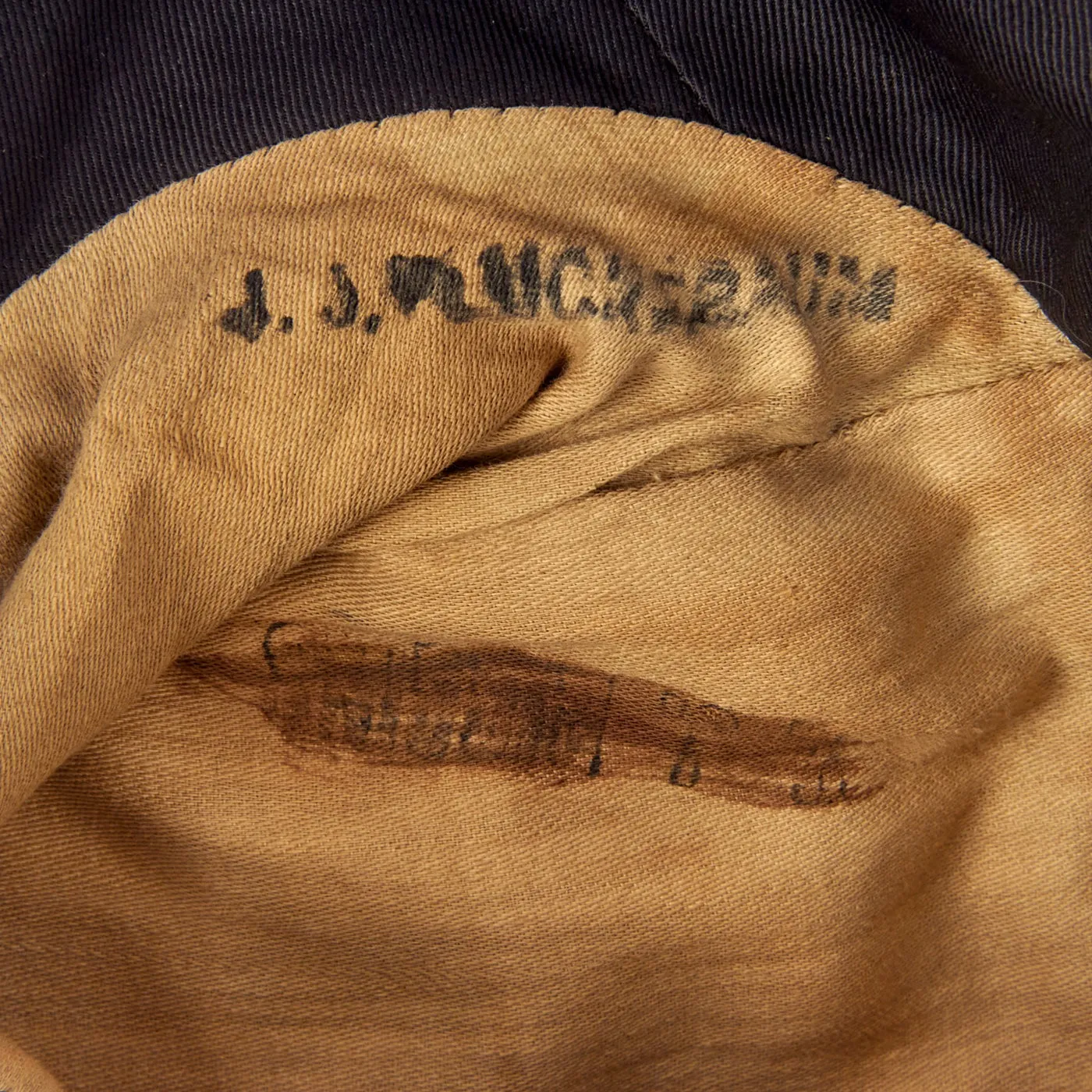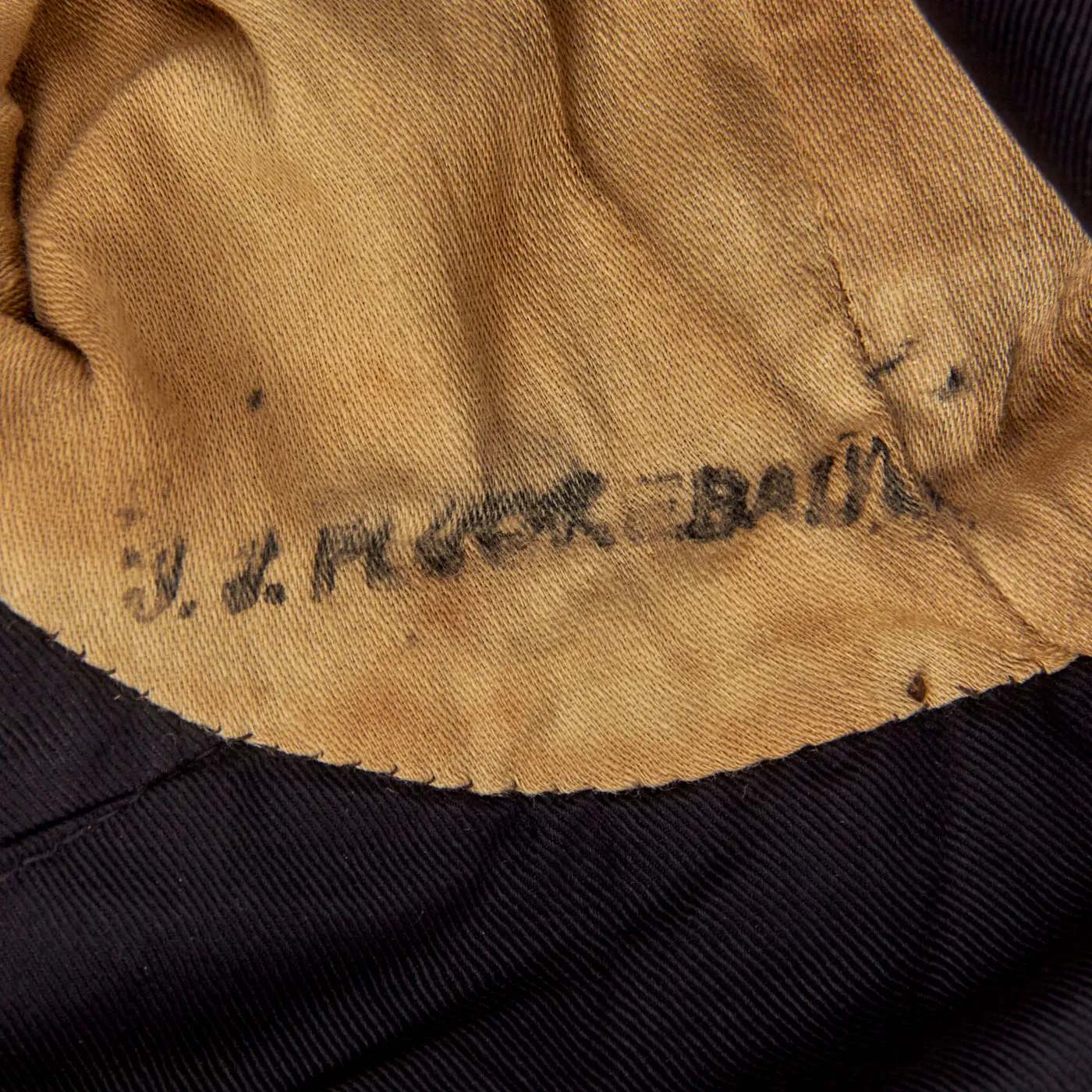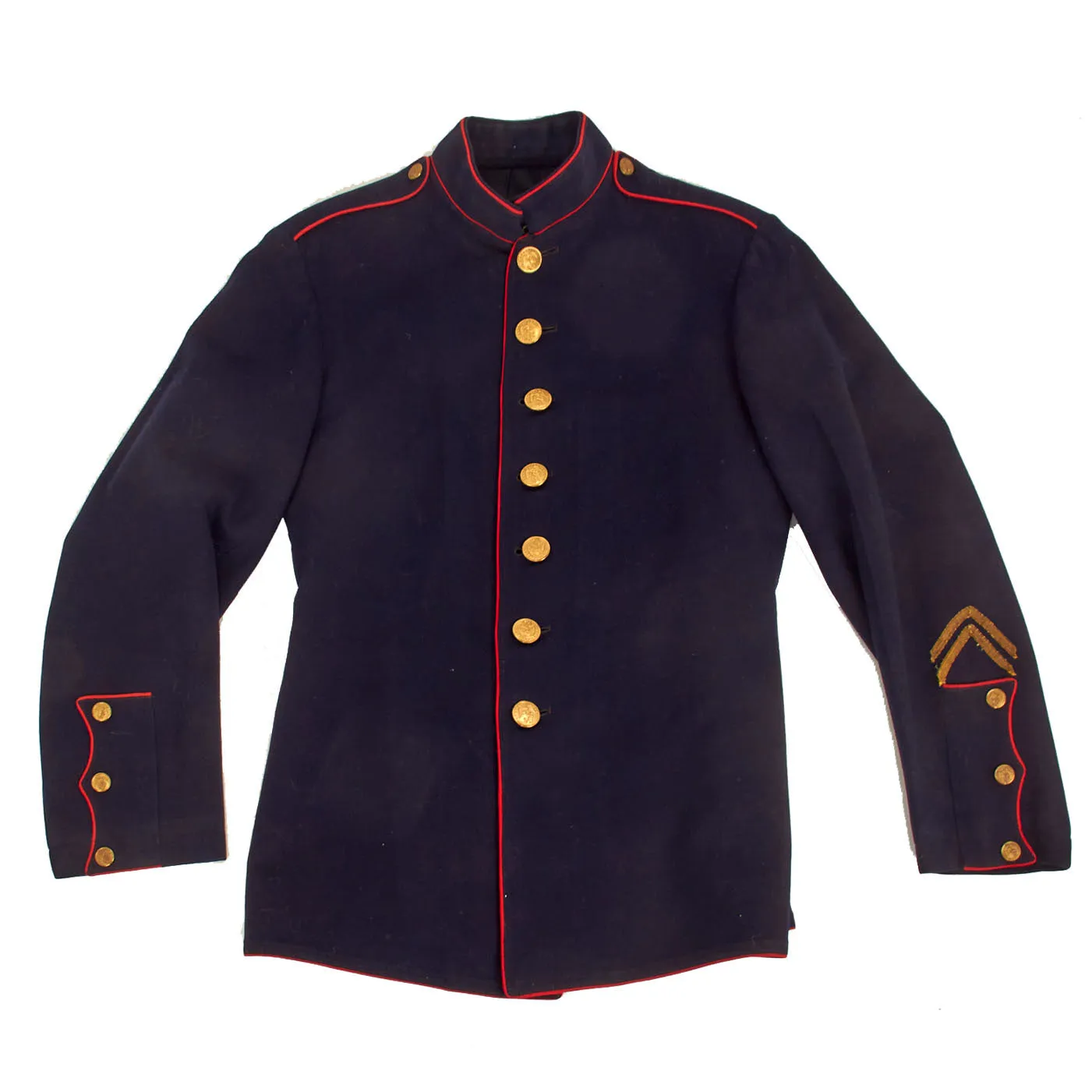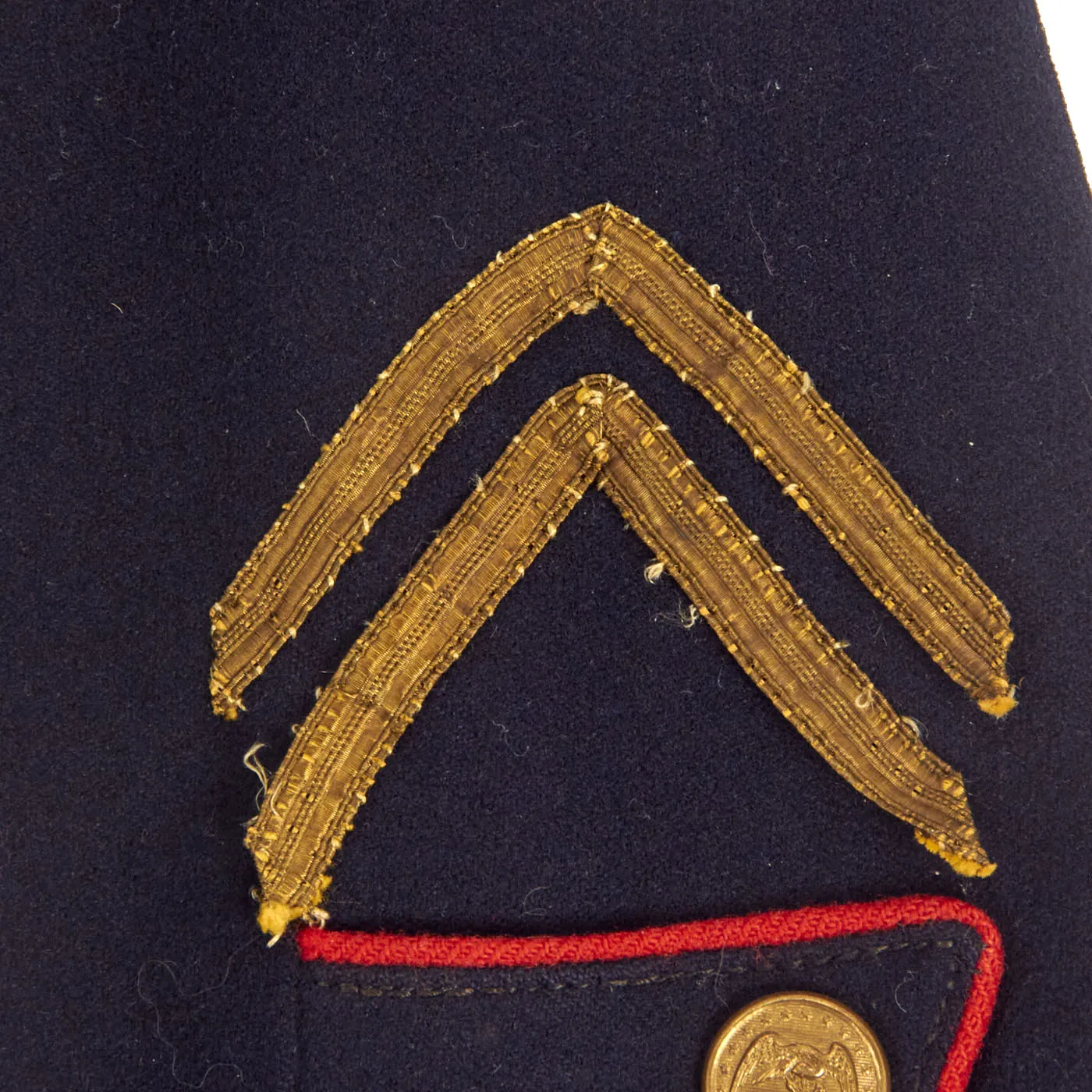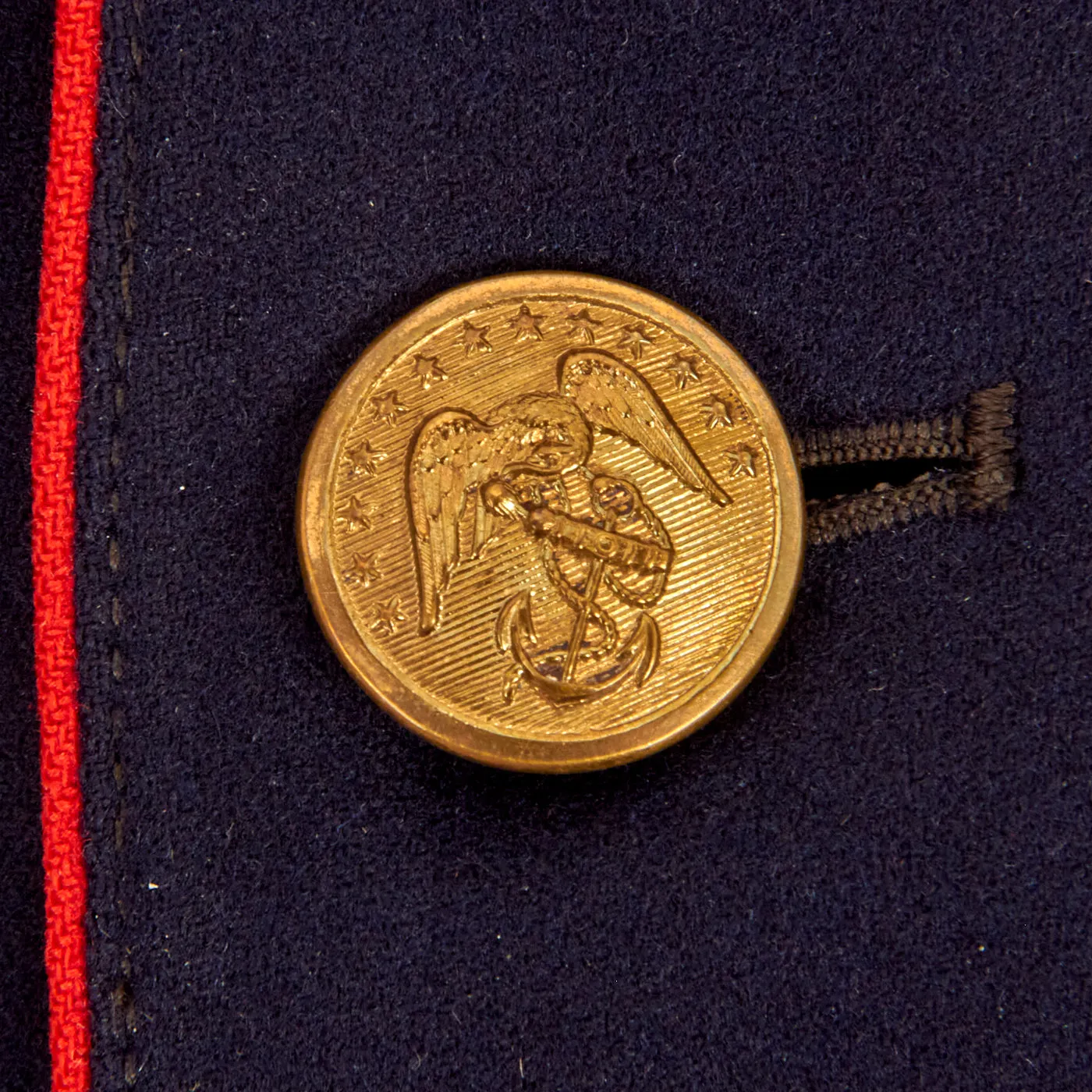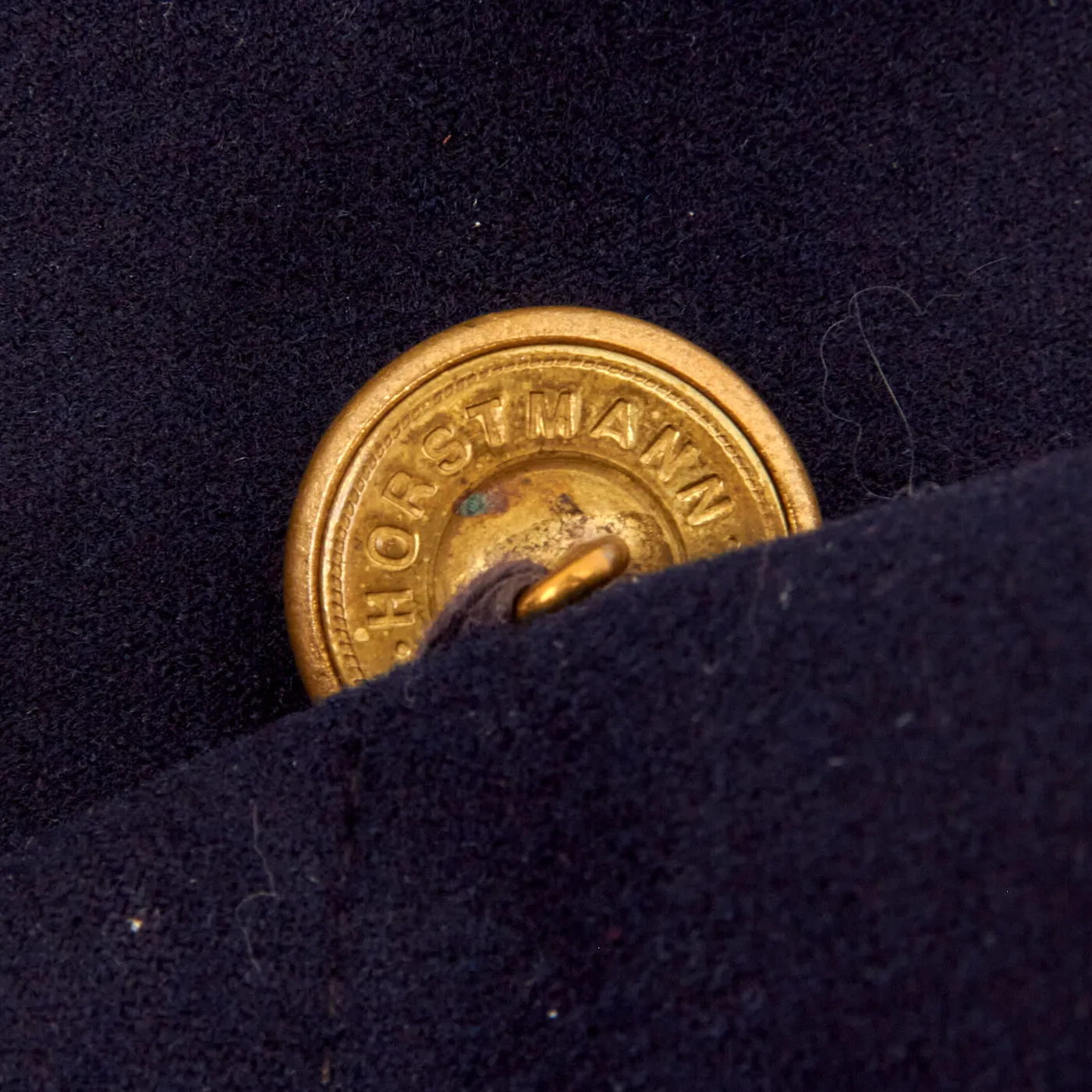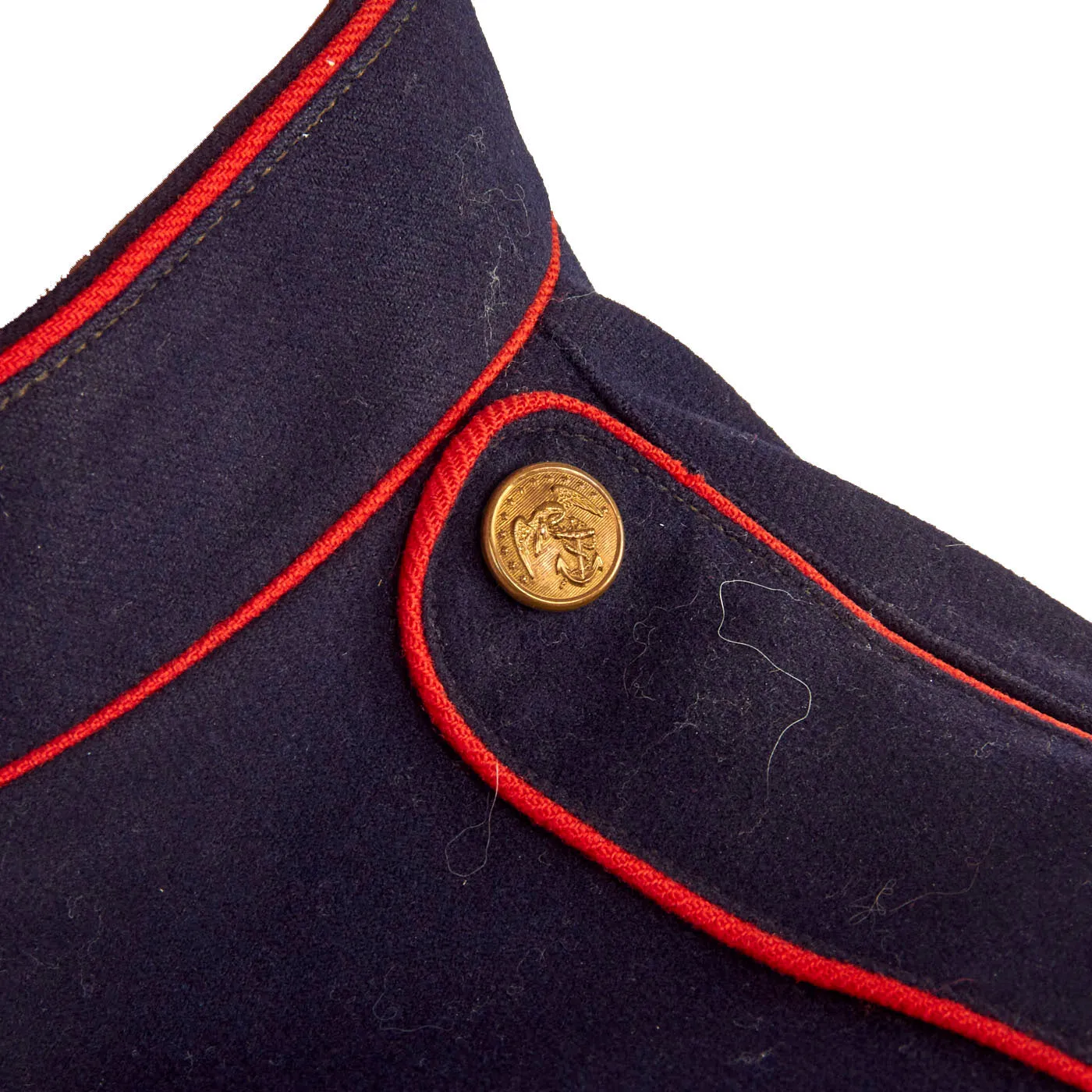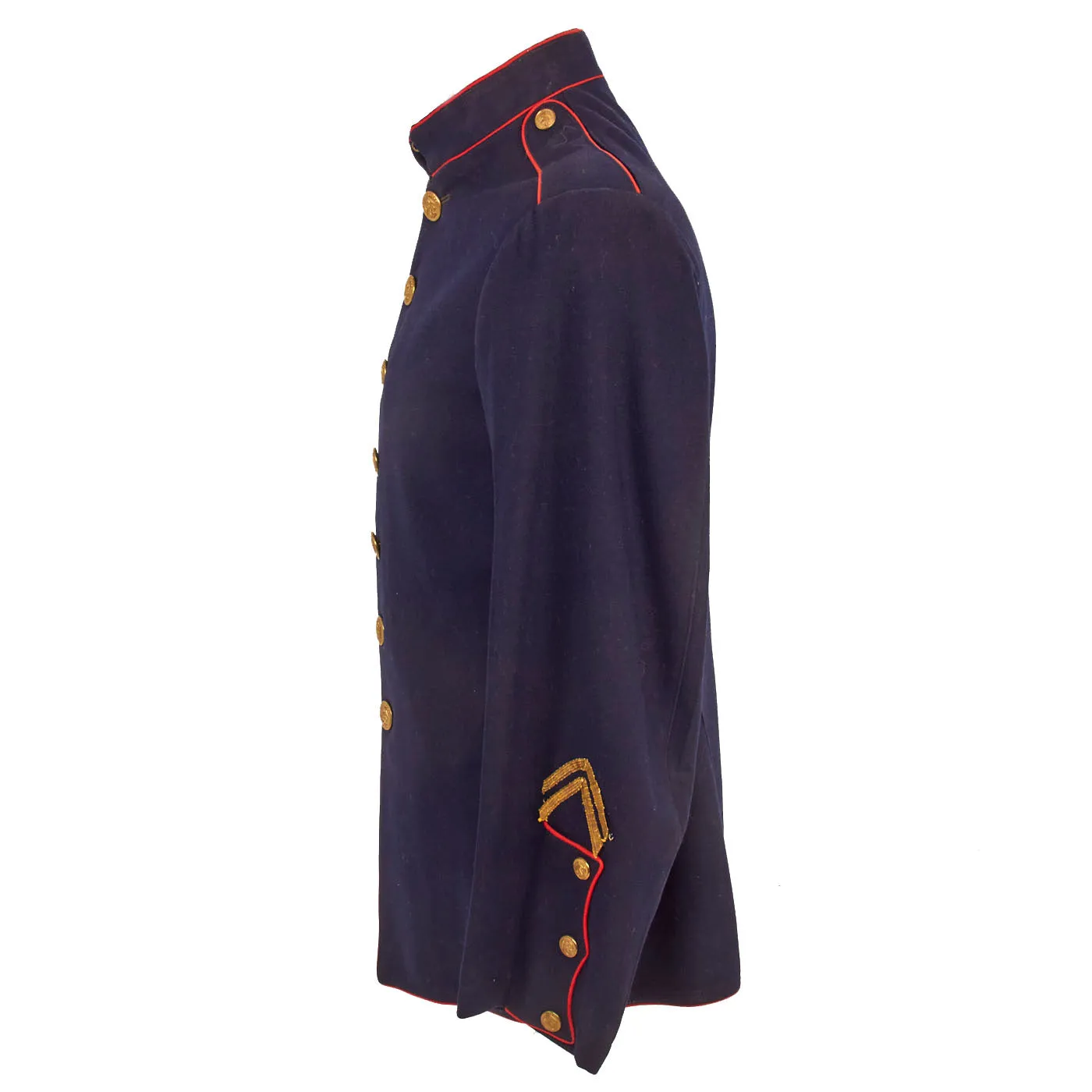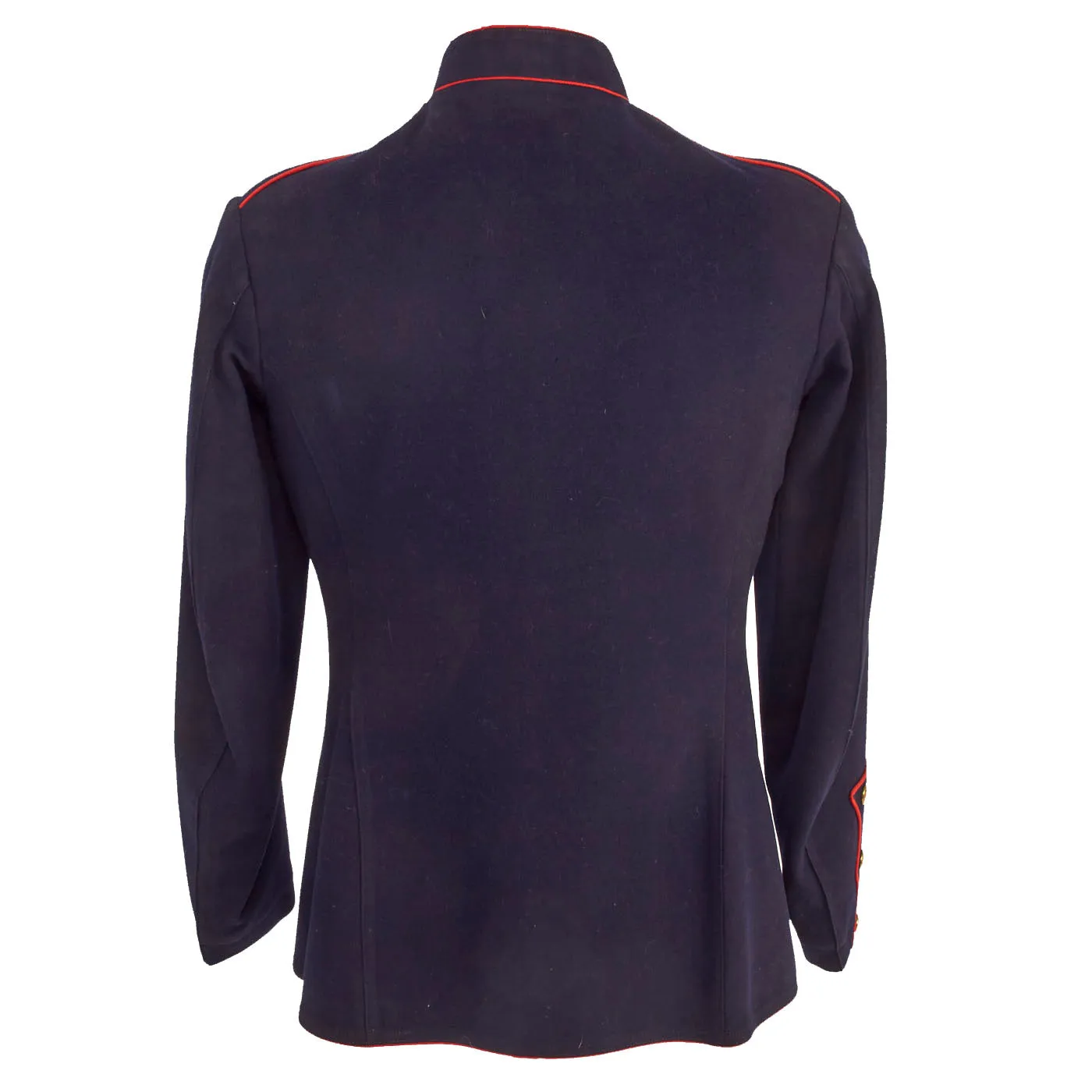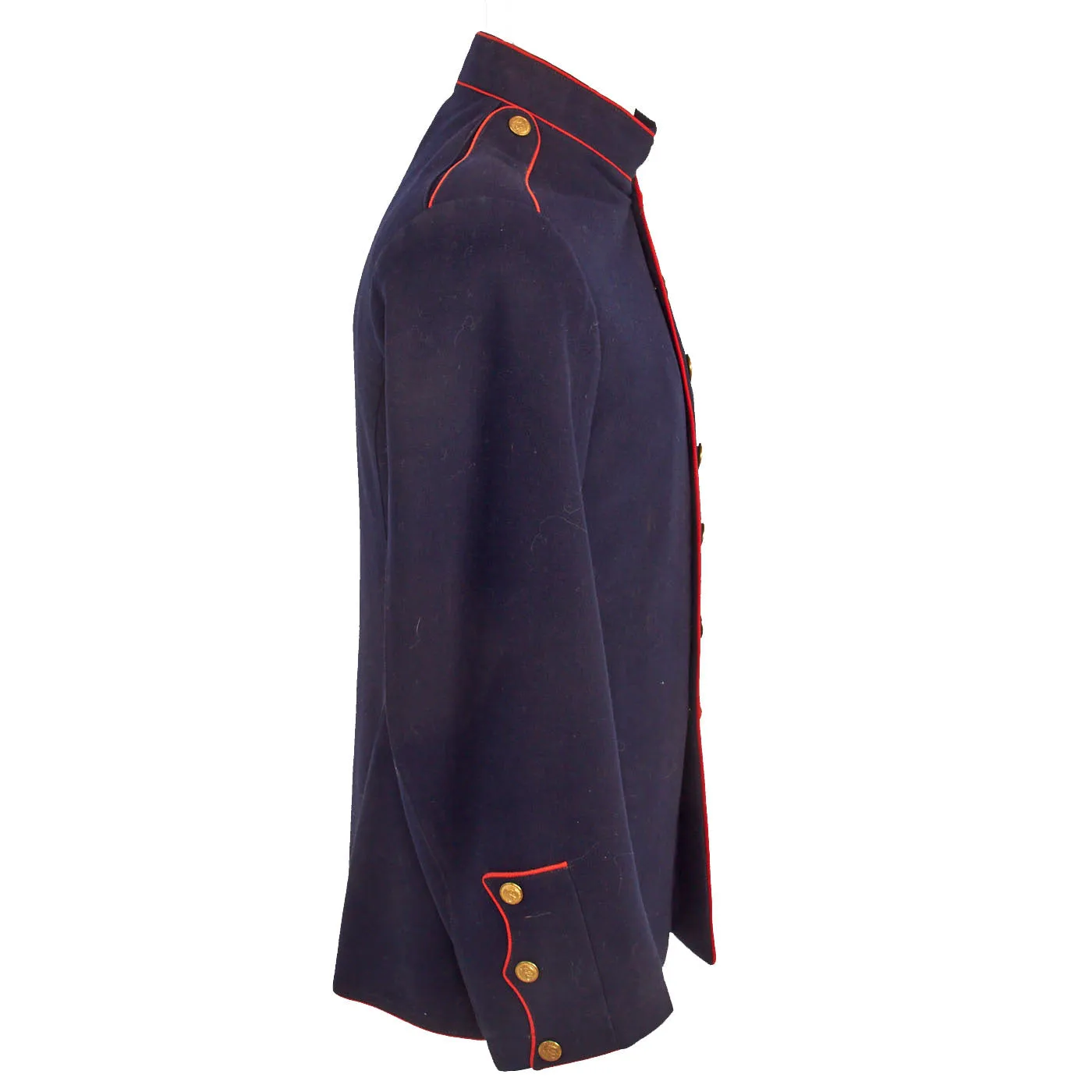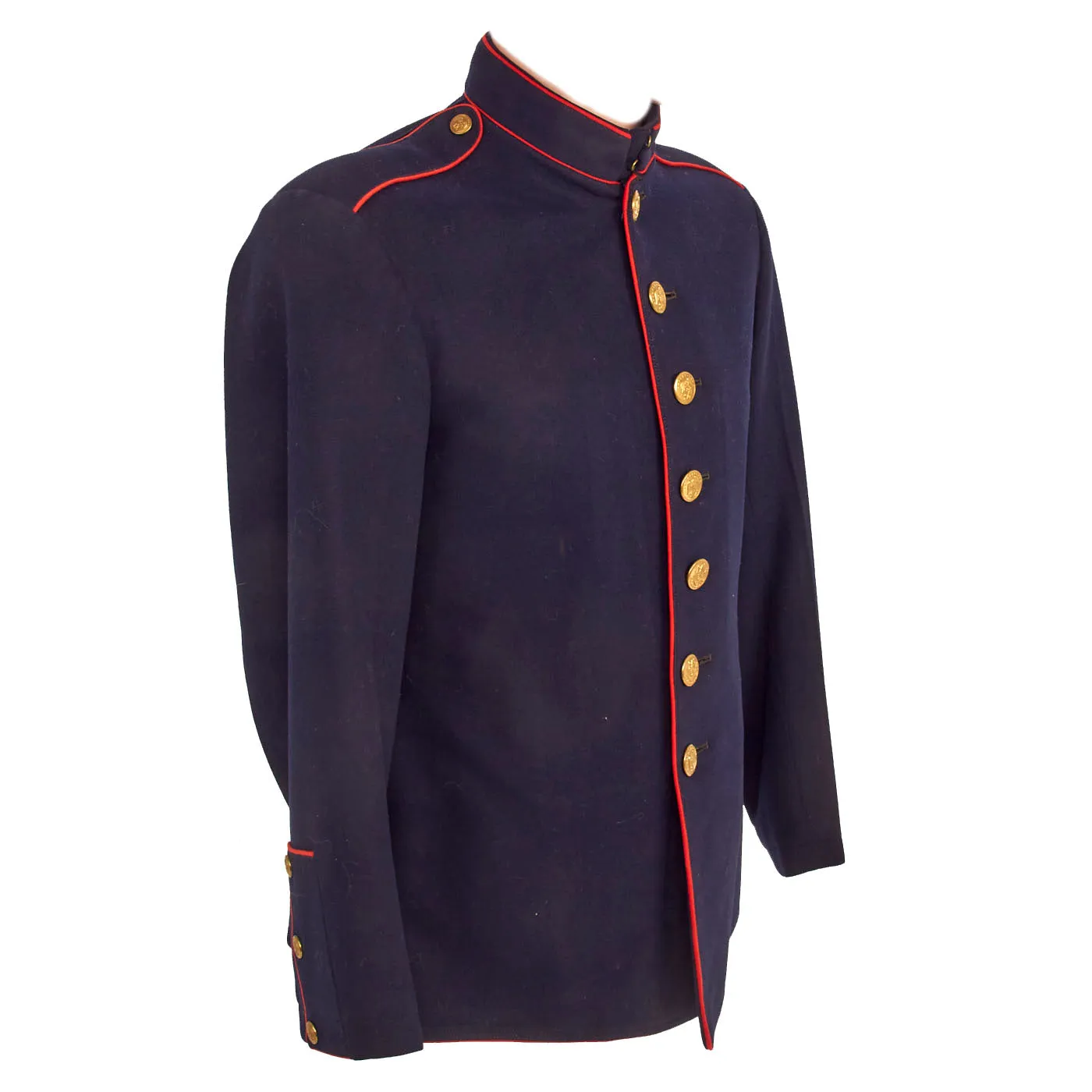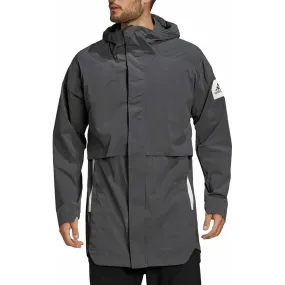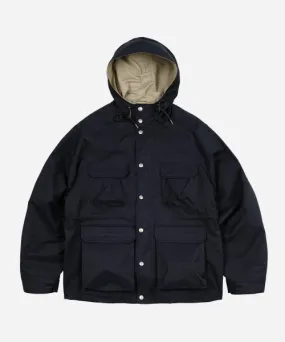Original Item: Only One Available. Marine Detachment or MarDet was a unit of 35 to 85 United States Marines aboard large warships including cruisers, battleships, and aircraft carriers. They were a regular component of a ship's company from the formation of the United States Marine Corps until the 1990s. Missions of the Marine Detachment evolved, and included protecting the ship's captain, security and defense of the ship, operating the brig, limited action ashore, securing nuclear weapons and ceremonial details.
Marines served aboard sailing ships as a small amphibious force able to capture and hold minor port facilities as required for protection of American interests. Marine sharpshooters were often stationed in the rigging during ship-to-ship combat to fire at officers and helmsmen aboard enemy warships. Marines often operated naval artillery during general quarters when the distances of gunnery engagements exceeded the range of small arms.
This uniform is twice named, but unfortunately the second name is scribbled over when it was re-issued. The “current” owner of the uniform is Jerome Joseph Pluckebaum, and his name can be found written in each armpit as J.J. PLUCKEBUAM. The name is hard to read due to ink bleeding, but there is no doubt in the identification.
Pvt. Pluckebaum enlisted in the United States Marine Corps on July 17, 1917 out of Dayton, Ohio. In August of 1917 he was seen mustering with Company A for Bootcamp aboard Parris Island, South Carolina. From 1917 to 1919 he is seen serving aboard various ships with the Marine Detachment during his career.
The Ships/Locations Served:
- October 1917, 60th Company Marine Barracks, Navy Yard, New York: The Brooklyn Navy Yard (originally known as the New York Navy Yard) is a shipyard and industrial complex located in northwest Brooklyn in New York City, New York. The Navy Yard is located on the East River in Wallabout Bay, a semicircular bend of the river across from Corlears Hook in Manhattan. It is bounded by Navy Street to the west, Flushing Avenue to the south, Kent Avenue to the east, and the East River on the north. During World War I, the six naval shipyards at Brooklyn, Boston, Charleston (South Carolina), Norfolk, Portsmouth (Maine), and Philadelphia started specializing in the construction of different vessel types for the war effort. The Brooklyn Navy Yard specialized in creating submarine chasers, manufacturing 49 of them in the span of eighteen months.
- November 1917, 61st Company Marine Barracks, New York Navy Yard & US Army Transport Ship Sheridan: In general only ships owned, under long term bareboat charter or allocation to the Army, first through the Quartermaster Corps and later the Transportation Corps, were formally designated as a U.S. Army Transport (USAT). The ship was built by Harland and Wolff, a heavy industrial company which specialized in shipbuilding and offshore construction, and was based in Belfast, Northern Ireland. The ship was first named SS Massachusetts, and was a passenger ship for Baltimore Lighterage Co, launched 17 December 1891, she was completed 5 March 1892, the maiden voyage was 24 April 1892, renamed USAT Sheridan and scrapped October 1923.
- December 1917 - January 1918, USS Utah: USS Utah (BB-31/AG-16) was the second and final member of the Florida class of dreadnought battleships. The first ship of the United States Navy named after the state of Utah, she had one sister ship, Florida. Utah was built by the New York Shipbuilding Corporation, laid down in March 1909 and launched in December of that year. She was completed in August 1911, and was armed with a main battery of ten 12-inch (305 mm) guns in five twin gun turrets. Utah and Florida were the first ships to arrive during the United States occupation of Veracruz in 1914 during the Mexican Revolution. The two battleships sent ashore a landing party that began the occupation of the city. After the American entrance into World War I, Utah was stationed at Berehaven in Bantry Bay, Ireland, where she protected convoys from potential German surface raiders. Throughout the 1920s, the ship conducted numerous training cruises and fleet maneuvers, and carried dignitaries on tours of South America twice, in 1924 and 1928.
- February 1918, USS Texas: USS Texas (BB-35) is a museum ship and former United States Navy New York-class battleship. She was launched on 18 May 1912 and commissioned on 12 March 1914. Texas saw action in Mexican waters following the "Tampico Incident" and made numerous sorties into the North Sea during World War I.
- March 1918, USS Utah
- April 1918, USS Wyoming: USS Wyoming (BB-32) was the lead ship of her class of dreadnought battleships and was the third ship of the United States Navy named Wyoming, although she was only the second named in honor of the 44th state. Wyoming was laid down at the William Cramp & Sons in Philadelphia in February 1910, was launched in May 1911, and was completed in September 1912. She was armed with a main battery of twelve 12-inch (305 mm) guns and capable of a top speed of 20.5 kn (38.0 km/h; 23.6 mph).
During the First World War, she was part of Battleship Division Nine, which was attached to the British Grand Fleet as the 6th Battle Squadron. During the war, she was primarily tasked with patrolling in the North Sea and escorting convoys to Norway.
- May 1918, USS Vermont: USS Vermont (BB-20), a Connecticut-class battleship, was the second ship of the United States Navy named after the 14th state. She was the third member of the class, which included five other ships. The Connecticut-class ships were armed with a main battery of four 12-inch (305 mm) guns and had a top speed of 19 knots (35 km/h; 22 mph). Vermont was laid down in May 1904 at the Fore River shipyard and launched in August 1905. The ship entered service with the Atlantic Fleet in March 1907.
Shortly after she entered service, Vermont joined the Great White Fleet for its circumnavigation of the globe in 1908–1909. She took part in the international Hudson–Fulton Celebration in New York in 1909 and made trips to Europe in 1910 and 1913. Thereafter, the ship became involved in interventions in several Central American countries, including the United States occupation of Veracruz during the Mexican Revolution, where two of her crew earned the Medal of Honor. During the United States' participation in World War I from April 1917 to November 1918, Vermont served as a training ship for engine room personnel.
- June 1918, USS Wyoming
- July 1918, USS Vermont
- August 1918, USS Utah
- September 1918, USS Vermont
- October 1918, USS Wyoming
- December 1918, USS Wyoming
- January 1919, USS Wyoming
As you can see, Private Pluckebaum had an extensive Marine Detachment career aboard multiple ships, and more than once on the same ship. After the war he returned home and was heavily involved with his local politics in Ohio and even holds patents for inventions, one of which being for bed sheet keepers! If there’s one thing the Marine Corps is good at producing, besides warfighters, is upstanding citizens!
The tunic is in great condition and shows signs of slight wear. All buttons and clasps are present as well as 2 service chevrons on the lower left sleeve, which are partially detached.
This is a wonderful example of a WWI US Marine Corps Dress Blues coat with great research potential. Comes more than ready for further research and display!
Approx. Measurements:
Collar to shoulder: 10”
Shoulder to sleeve: 17”
Shoulder to shoulder: 22.5”
Chest width: 18”
Waist width: 16.5”
Hip width: 19.5”
Front length: 28.5"
A close-cropped nape sheathed behind a rigid, red-trimmed collar. White gloves folded perfectly—left over right—across a flawless brass buckle. A scarlet stripe along the seam of blue trousers lead to a pair of black shoes polished so highly that you can count in their reflection six gold buttons leading up the broad, medal-adorned chest of a U.S. Marine.
The Marine Corps dress blue uniform is distinct in its simplicity and is said to be steeped in nearly 241 years of tradition. A Marine in his dress blues is who many Americans picture when they hear the phrase “man in uniform.”




